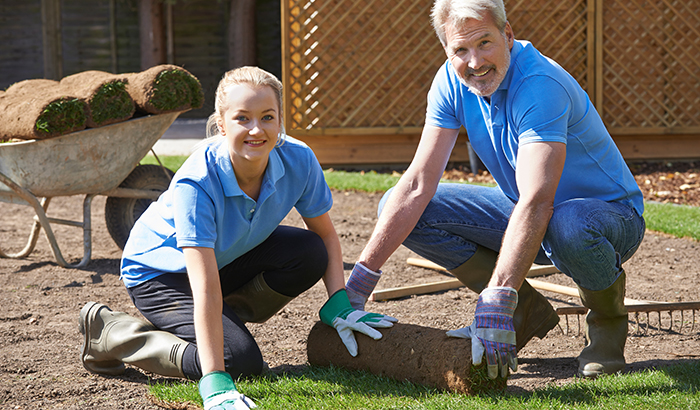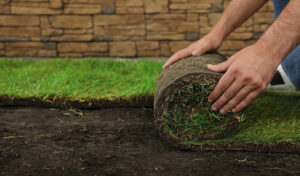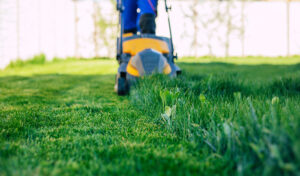If you are trying to restart your lawn, you may want to know more about how to lay sod. Installing sod at the wrong time of year can cause your sod’s roots to fail and the grass to die.
Because grass is sensitive to temperature, you need to be sure you are installing your sod at the right time of year. Timing will make the difference between a luscious green lawn and a thin, browning one.
Here are some tips for laying sod that will help you know when and how to install your sod.
What Is the Ideal Temperature for Growing Sod?
Every type of sod is different. Some are more heat tolerant, and others prefer cooler weather for growing. Generally, the best temperature for installing sod is when average temperatures hover between 55-70 degrees Fahrenheit.
How cold is too cold for grass?
Plants have an ideal temperature for growth. If average temperatures fall below 40 Fahrenheit, a plant’s chemical response signals the cells to slow production and temporarily shut down.
This response allows plants to survive in cold climates. To survive cold temperatures, plants need to be rooted into the soil, where they can detect temperature and the presence of liquid in the soil.
How hot is too hot?
Most grasses and plants in our yards here in Utah are not very heat or drought-tolerant.
Plants need water and sunlight to create food. The process of photosynthesis uses sunlight and water to create sugar for plants to use for energy. Without water, there can be no food.
When temperatures are hot and dry, plants begin to lose water through transpiration, the process of losing water from leaves. As this continues, plants will not be capable of making food or maintaining normal chemical functions. If exposed to too much heat, plants will die.
This is more prominent when temperatures reach above 90 Fahrenheit and stay there for a while. When temperatures are consistently this hot, some plants won’t be able to maintain enough water to survive, causing them to wilt and die.
The Goldilocks Temperature for Plants
Based on the coldest and hottest temperatures most plants can withstand, you should do most or all of your gardening and growing when temperatures average between 45-85 degrees Fahrenheit.
This goldilocks zone is just right for plant growth. However, trying to grow plants when temperatures are below or above these temperatures may prove to be futile.
Since sod is already full-grown grass, it should be capable of taking root and growing at any point in this goldilocks zone. However, aim to lay sod for best results when temperatures are in the middle of the goldilocks zone—between 55-70 degrees.
The Best Months for Laying Sod
For the best results growing sod, you should plan to install sod when the weather averages in the goldilocks range for plants.
Here in Utah, the best time to install sod is during the spring and fall seasons. Specifically, you can lay sod beginning – late March through early June and in early September to early October.
The weather in Utah can be pretty volatile in the early part of spring and early fall. The closer you can plant sod where temperatures average between 55-70 Fahrenheit, the better your results will be.
Planting too early may subject your sod to an unexpected freeze which could send your grass into shock at best or kill it at worst.
Characteristics of Grass
Grass is as diverse as any other species of plant on the earth. In Utah, there are three types of grass that are well suited for the climate and are commonly used. Most sod is a mixture of two or three of these different grasses, but general care remains the same.
The three types of grass most commonly used in Utah are:
- Kentucky Bluegrass
- Perennial Ryegrass
- Tall Fescue
These three types of grass are known for their winter hardiness. They won’t be growing during the cold season, but their roots will be able to withstand the sub-freezing temperatures and grow back the following year.
Each grass has its benefits and drawbacks. Here’s what you need to know about each type of grass.
Kentucky Bluegrass
Kentucky Bluegrass is known for its rich green color. This grass is perfect for open fields and has good regenerative abilities. It primarily propagates well across the ground, using its fast-growing roots to spread over open ground and form a thick cover quickly.
Growing Kentucky Bluegrass may not be the best option for your home if your property has a lot of shade or is in a drought-prone region. Kentucky Bluegrass is a full-sun plant. It needs more direct sunlight than other types of grass and could wither without it. It also has shallow roots, which make it less drought-resistant than other grasses.
Perennial Ryegrass
Perennial Rygrass is suitable for most moderate-cool climates. This grass grows faster than other grasses making it great for pastures and temporary lawns. It is a cold-season grass and can thrive in moderately cold environments. Though it will go dormant in the winter, Perennial Ryegrass will return in the spring, making it great for permanent lawns.
This grass is great for seeding and sod mixtures because it can establish itself fast, taking root and staying firm while other grasses try to establish themselves.
Tall Fescue
Tall Fescue is versatile and adaptable. This grass establishes deep roots that help it survive droughts and cold weather. In addition to drought tolerance, this grass grows well in shady areas.
Once established, this grass is great for most yards in Utah. Its drought-resistant capabilities are especially useful now that Utah is well into a drought. Its growth pattern makes it easy to contain but hard to regenerate. All around, this grass is great for Utah’s moderate and dry climate.
Get the Best Sod Installation With Monarch Sod
If you want a super-green, lucious, and beautiful lawn that is drought-tolerant, we can help you here at Monarch Sod.
Not only can we help you install a rich and vibrant lawn of Kentucky Bluegrass, but we can also set you up with a drought-tolerant sod mixture that will keep your ground covered and help you use less water while Utah is in a drought.
Contact us to today to learn more information on how to lay sod and sod installation.












